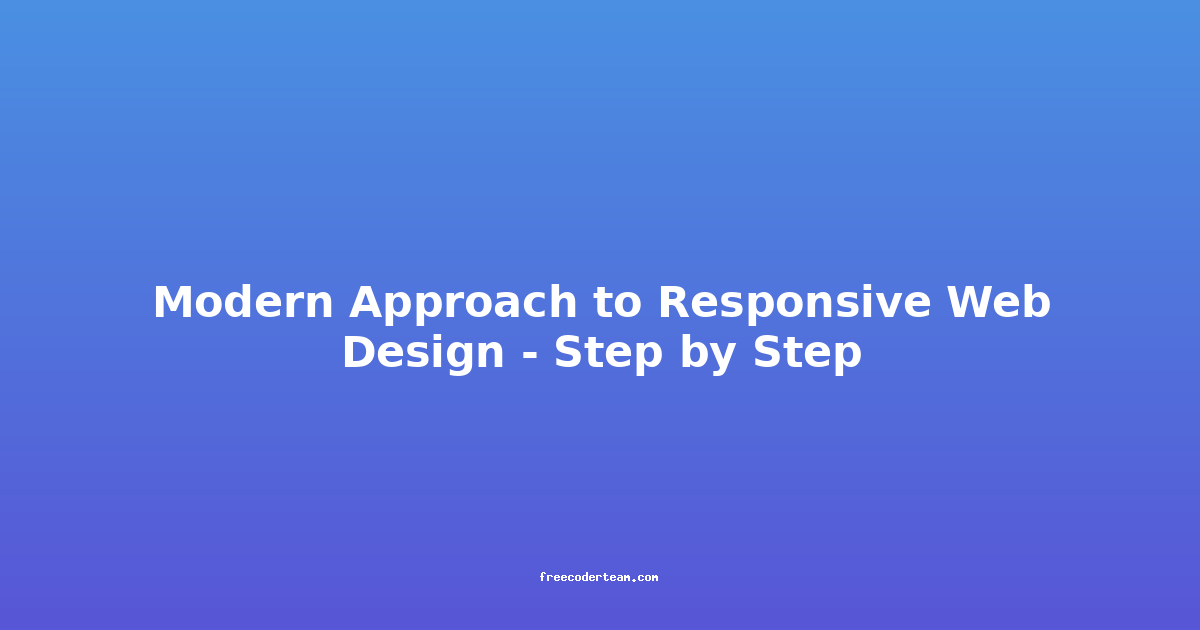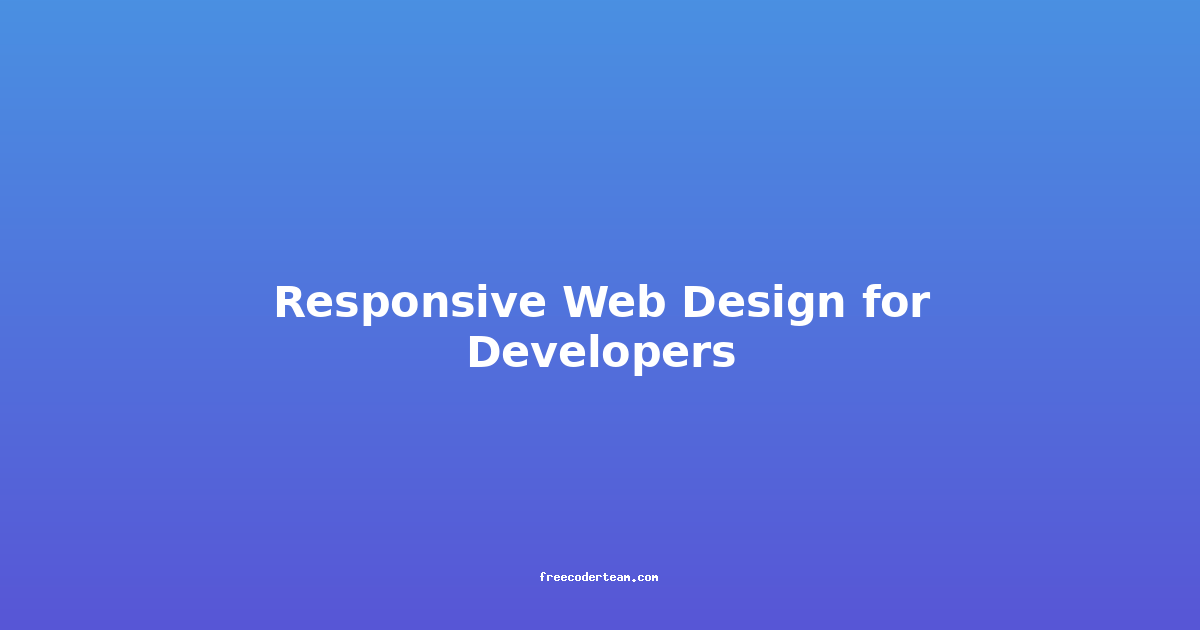Modern Approach to Responsive Web Design: Step by Step
In the ever-evolving digital landscape, responsive web design (RWD) remains a cornerstone of creating effective, user-friendly websites. With the proliferation of devices—ranging from smartphones and tablets to laptops and desktops—designing a website that adapts seamlessly to various screen sizes and orientations is no longer optional; it’s essential.
In this comprehensive guide, we’ll explore the modern approach to responsive web design, step by step. We’ll cover best practices, practical examples, and actionable insights to help you build websites that deliver an exceptional user experience across all devices.
Table of Contents
- Understanding Responsive Web Design
- Key Principles of RWD
- Step-by-Step Guide to Implementing RWD
- Best Practices for Modern RWD
- Practical Examples
- Tools and Resources for RWD
- Conclusion
Understanding Responsive Web Design
Responsive web design is an approach that ensures a website's layout, content, and functionality adapt dynamically to the device and screen size of the user. The goal is to provide a consistent and optimal user experience regardless of whether someone is browsing on a 4-inch smartphone or a 27-inch desktop monitor.
The core idea behind RWD is to create a single, fluid layout that resizes and reflows in response to the viewport (the visible area of the screen). This eliminates the need for separate sites for desktop and mobile devices, saving development time and maintenance costs.
Key Principles of RWD
Before diving into the implementation, let’s review the foundational principles of responsive web design:
1. Flexible Grids
- Use relative units like percentages,
em, orremto define layout dimensions, ensuring that elements resize proportionally.
2. Flexible Images and Media
- Ensure images and media elements are scalable without losing quality, often using
max-width: 100%and relative units.
3. Media Queries
- Use CSS media queries to apply different styles based on the device’s screen size, orientation, or resolution.
4. Mobile-First Approach
- Design for mobile devices first, then progressively enhance the layout for larger screens.
5. Performance Optimization
- Optimize assets (images, scripts, stylesheets) to ensure fast loading times on all devices.
Step-by-Step Guide to Implementing RWD
Step 1: Mobile-First Design
The mobile-first approach prioritizes designing for smaller screens and progressively enhancing the layout for larger devices. This ensures that the core content and functionality are optimized for mobile users, who often have slower internet connections and smaller screens.
Why Mobile-First?
- Focuses on essential content first.
- Reduces unnecessary complexity.
- Ensures faster load times for mobile users.
Example: Basic HTML Structure
<!DOCTYPE html>
<html lang="en">
<head>
<meta charset="UTF-8">
<meta name="viewport" content="width=device-width, initial-scale=1.0">
<title>Mobile-First Example</title>
<style>
/* Default styles for all devices */
body {
font-family: Arial, sans-serif;
margin: 0;
padding: 0;
box-sizing: border-box;
}
.container {
max-width: 960px;
margin: 0 auto;
padding: 20px;
}
.header {
background: #f4f4f4;
padding: 20px;
text-align: center;
}
.content {
padding: 20px;
}
</style>
</head>
<body>
<div class="container">
<header class="header">
<h1>Welcome to Our Website</h1>
</header>
<main class="content">
<p>This is a mobile-first design example.</p>
</main>
</div>
</body>
</html>
Step 2: Use of Flexbox and Grid
CSS Flexbox and Grid are powerful tools for creating flexible and responsive layouts. They allow you to build complex layouts that adapt automatically to different screen sizes.
Flexbox Example
/* Flexbox for a simple navigation bar */
.navbar {
display: flex;
justify-content: space-between;
align-items: center;
padding: 10px;
background: #333;
color: white;
}
.navbar ul {
list-style: none;
display: flex;
gap: 20px;
}
.navbar ul li a {
color: white;
text-decoration: none;
}
Grid Example
/* Grid for a two-column layout */
.grid-container {
display: grid;
grid-template-columns: repeat(auto-fit, minmax(300px, 1fr));
gap: 20px;
padding: 20px;
}
.grid-item {
background: #f4f4f4;
padding: 20px;
}
Step 3: Media Queries
Media queries allow you to apply specific styles based on the device’s screen size, orientation, or resolution. This enables you to tailor the layout for different devices.
Basic Media Query Example
/* Default styles */
body {
font-size: 16px;
}
/* Media query for screens larger than 768px */
@media (min-width: 768px) {
body {
font-size: 20px;
}
.header {
text-align: left;
}
}
/* Media query for screens larger than 992px */
@media (min-width: 992px) {
.container {
max-width: 1200px;
}
}
Step 4: Fluid Typography and Images
To ensure a smooth user experience, typography and images should scale fluidly with the viewport.
Fluid Typography
/* Use `rem` units for scalable typography */
body {
font-size: 16px; /* 1rem */
}
@media (min-width: 768px) {
body {
font-size: 18px;
}
}
h1 {
font-size: 2rem;
}
h2 {
font-size: 1.5rem;
}
Fluid Images
img {
max-width: 100%;
height: auto;
}
Step 5: Performance Optimization
Fast loading times are crucial, especially on mobile devices. Here are some optimization tips:
- Minify CSS and JavaScript to reduce file sizes.
- Optimize images using tools like TinyPNG or ImageOptim.
- Lazy load images to defer loading images that aren’t initially in the viewport.
- Use browser caching to reduce the number of HTTP requests.
Lazy Loading Example
<img src="placeholder.png" data-src="large-image.jpg" alt="Example Image" class="lazy">
JavaScript for Lazy Loading
document.addEventListener("DOMContentLoaded", function () {
const lazyImages = document.querySelectorAll(".lazy");
function lazyLoad() {
lazyImages.forEach((img) => {
if (img.getBoundingClientRect().top < window.innerHeight && img.getBoundingClientRect().bottom >= 0) {
img.src = img.dataset.src;
img.classList.remove("lazy");
}
});
}
window.addEventListener("scroll", lazyLoad);
lazyLoad();
});
Best Practices for Modern RWD
-
Use Relative Units: Always use relative units like
%,em,rem, orvwfor dimensions to ensure responsiveness. -
Prioritize Content: Focus on delivering the most critical content first, especially for mobile users.
-
Test Across Devices: Regularly test your site on various devices and browsers to ensure consistency.
-
Accessibility: Ensure your design is accessible by following WCAG guidelines, using semantic HTML, and providing adequate contrast.
-
Use Modern Tools: Leverage modern CSS features like Flexbox and Grid for efficient layouts.
Practical Examples
Example 1: Responsive Navigation
<nav class="navbar">
<div class="logo">
<h1>Logo</h1>
</div>
<ul class="menu">
<li><a href="#">Home</a></li>
<li><a href="#">About</a></li>
<li><a href="#">Services</a></li>
<li><a href="#">Contact</a></li>
</ul>
</nav>
.navbar {
display: flex;
justify-content: space-between;
align-items: center;
padding: 10px;
background: #333;
color: white;
}
.menu {
display: flex;
gap: 20px;
}
.menu li a {
color: white;
text-decoration: none;
}
/* Responsive menu for smaller screens */
@media (max-width: 768px) {
.menu {
display: none;
}
.navbar .logo {
margin: auto;
}
.navbar .menu-toggle {
display: block;
font-size: 2rem;
color: white;
cursor: pointer;
}
}
Example 2: Fluid Layout with Media Queries
<div class="grid-container">
<div class="grid-item">Item 1</div>
<div class="grid-item">Item 2</div>
<div class="grid-item">Item 3</div>
</div>
.grid-container {
display: grid;
grid-template-columns: repeat(auto-fit, minmax(250px, 1fr));
gap: 20px;
padding: 20px;
}
.grid-item {
background: #f4f4f4;
padding: 20px;
}
Tools and Resources for RWD
- Bootstrap: A popular framework for responsive design.
- Tailwind CSS: A utility-first CSS framework for rapid development.
- Am I Responsive?: A tool to visualize how your website looks on different devices.
- Google Lighthouse: A tool for auditing website performance, including responsiveness.
Conclusion
Responsive web design is no longer a luxury but a necessity in today’s digital world. By following a mobile-first approach, leveraging modern CSS features like Flexbox and Grid, and optimizing performance, you can create websites that adapt seamlessly to any device.
Remember, the goal of RWD is not just to make your site look good on different screens, but to provide a seamless and engaging user experience across all devices. With the right tools, best practices, and a focus on user needs, you can build websites that thrive in the responsive age.
Feel free to explore these concepts further and experiment with different techniques to refine your responsive design skills!
References:




